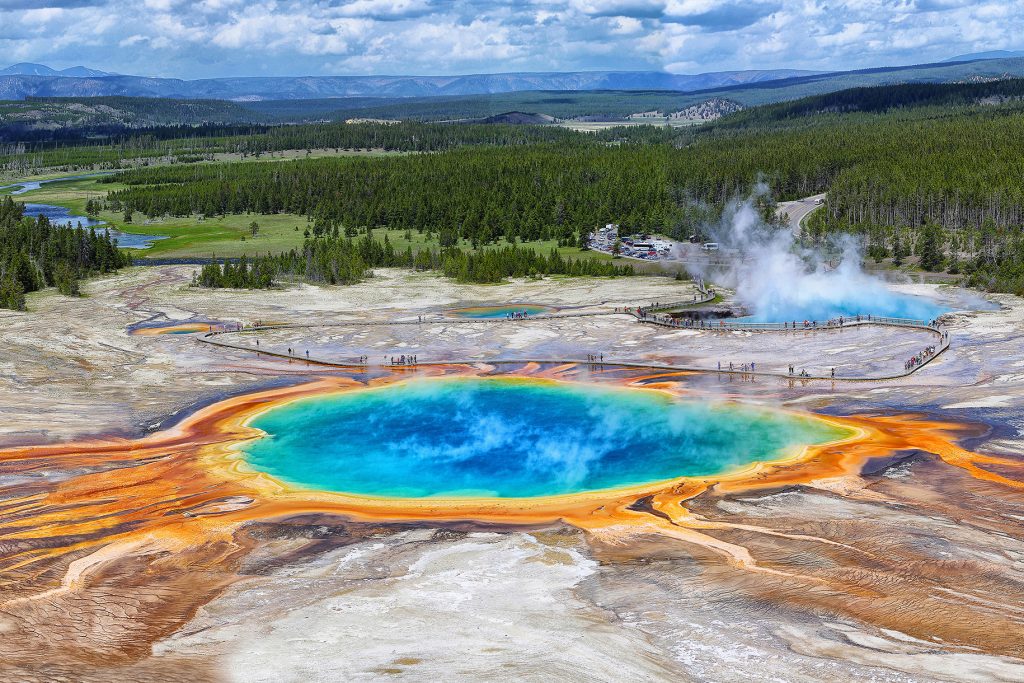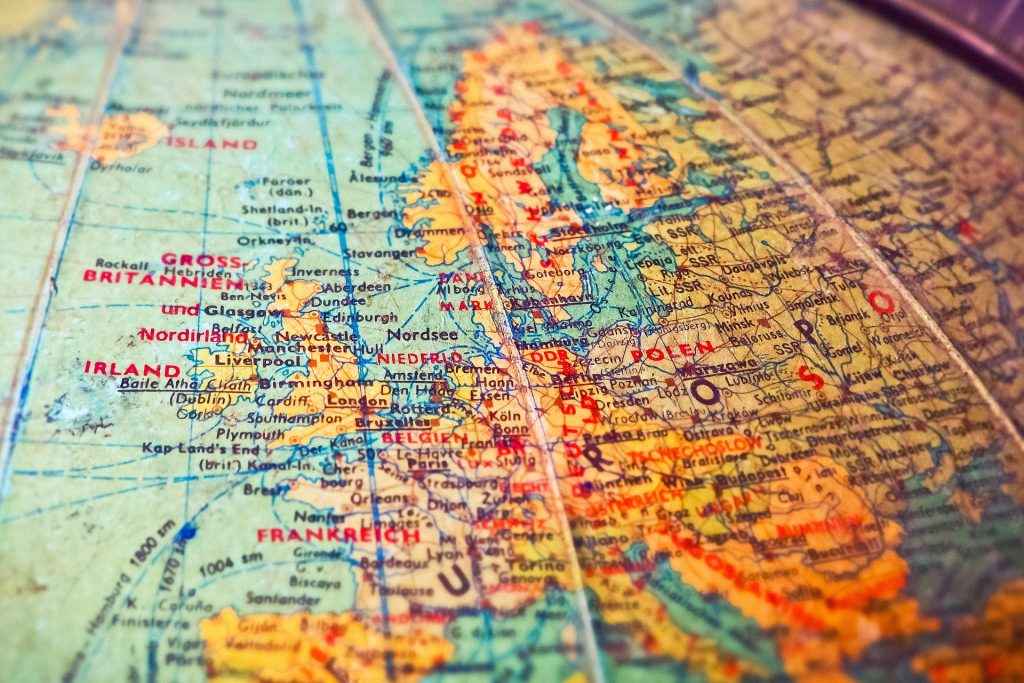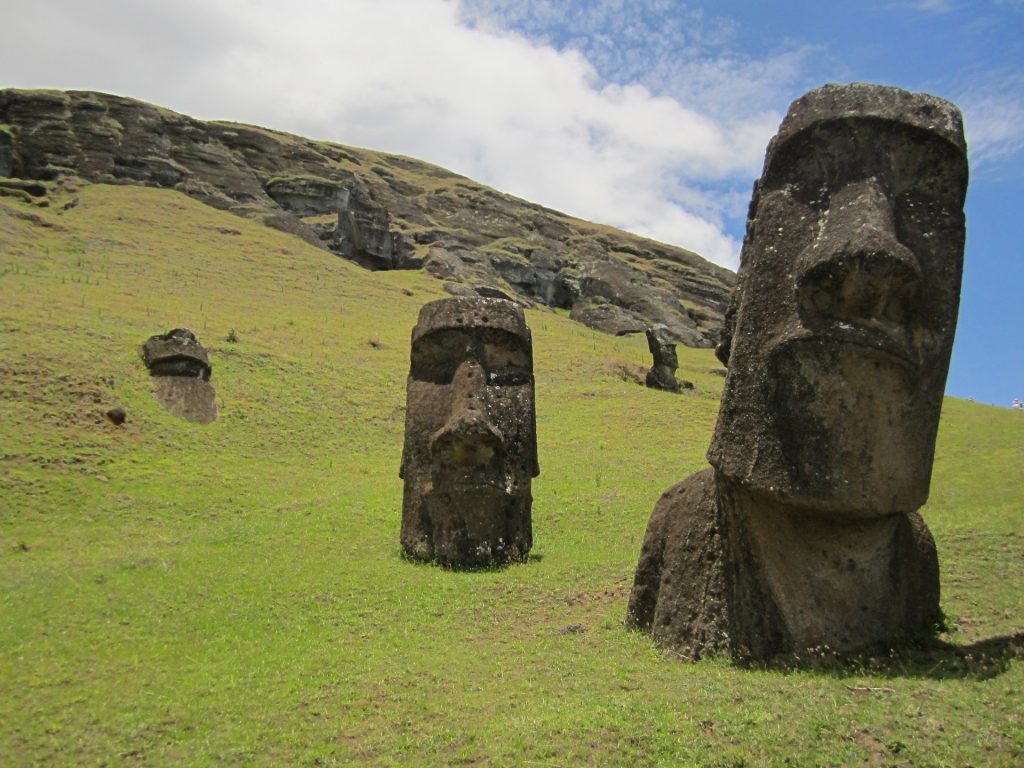Formation of a Supervolcano
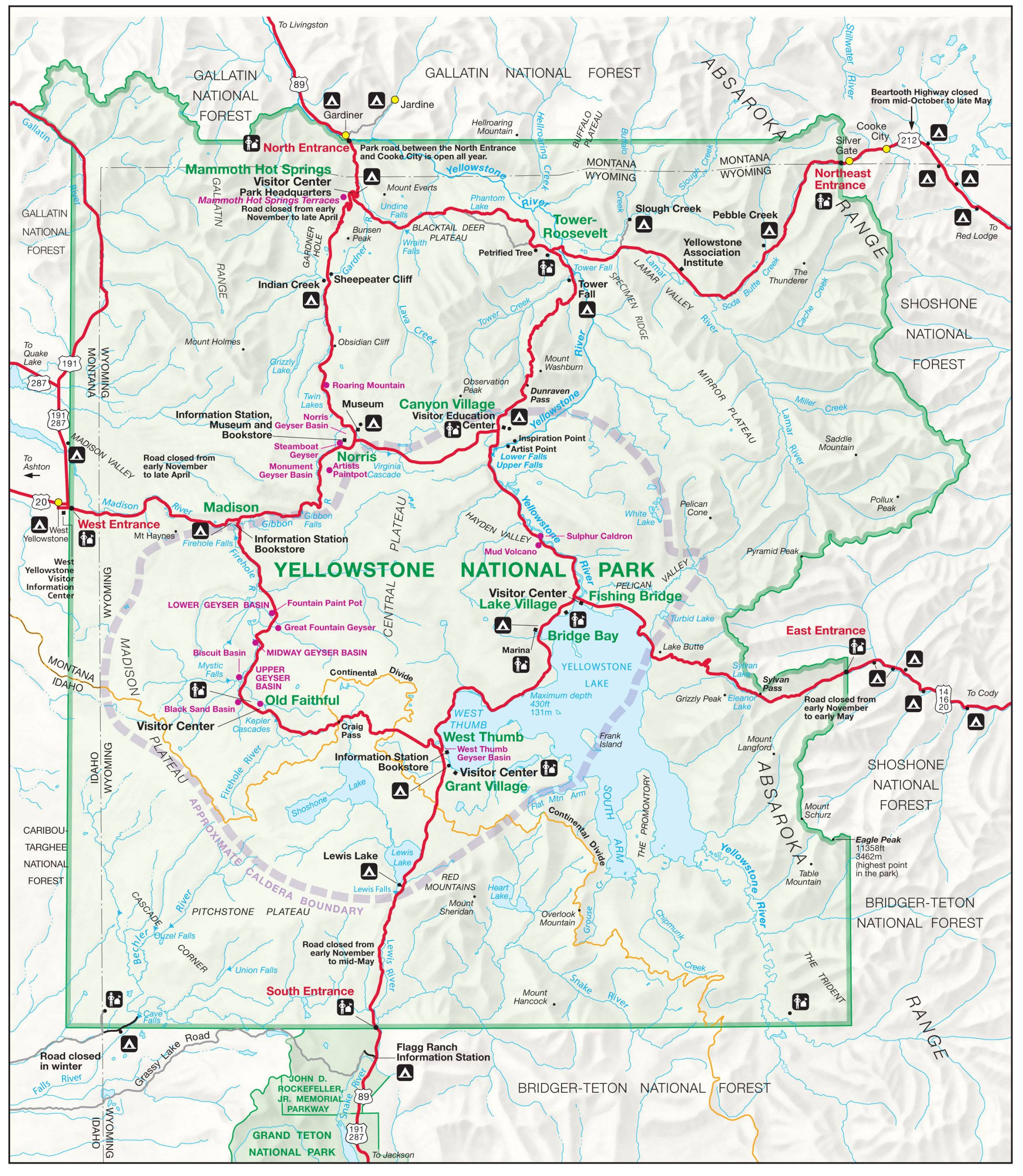
Tucked away in the very northeastern corner of Wyoming, and spilling out into Montana and Idaho is an area of outstanding natural beauty, beloved by tourists and natives alike. So beloved, in fact, that in 1872, President Ulysses S Grant declared it to be the first national park in the US and the second national Park on earth. We are, of course, talking of Yellowstone National Park. Scratch beneath the surface and you’ll find the Yellowstone hotspot, a plume of molten rock rising from deep within the Earth’s mantle. Interestingly, tectonic activity is causing the North America plate to slide over the magma chamber whilst the chamber itself stays put in relation to the center of the earth. As it does so, the magma chamber grows….and grows. Very occasionally, but ominously consistently, the magma chamber can grow no more and must release pressure in a violent eruption, the likes of which has not happened in the entire existence of human memory.
The Yellowstone volcanic field has experienced three major eruptions in the past 2.1 million years:
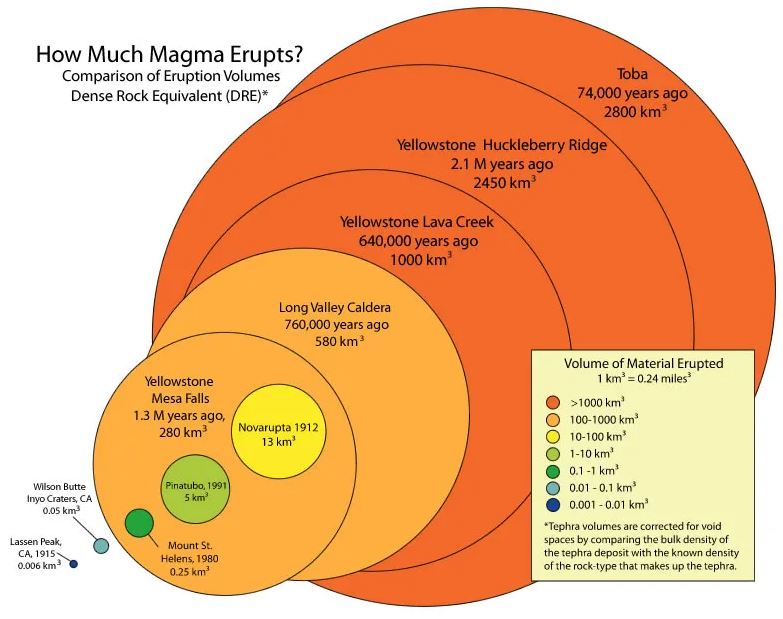
The Huckleberry Ridge Eruption (2.1 Million Years Ago)
The first and largest of Yellowstone’s three major eruptions, known as the Huckleberry Ridge eruption, occurred approximately 2.1 million years ago. This eruption was truly colossal, ejecting an estimated 2,450 cubic kilometers (588 cubic miles) of volcanic material. To put this into perspective, Mount St. Helens ejected just 0.25 kilometres in its eruption of 1980. The Huckleberry Ridge eruption ejected 6000 times that amount of hot magma, ash and rock high up into the atmosphere.
If you were around 2.1 million years ago, the first thing you’re going to want to do is stand back. The caldera alone was 100km across. But don’t worry – even from many hundreds of kilometers away, you would be able to observe the 50km high plume of ejecta. It was colossal.
The ash and gases released into the atmosphere would have had profound climatic effects, likely killing every living organism within many hundreds of miles and causing a global volcanic winter for anything that survived. This period of global cooling would have drastically affected plant and animal life, leading to significant ecological disruptions.
The Huckleberry Ridge eruption created the Huckleberry Ridge Tuff, a widespread deposit of ash and pumice that can be seen in the geological record seeing the world. The eruption’s sheer volume caused the ground above the magma chamber to collapse, forming the massive caldera, one of the largest calderas on Earth.
The Mesa Falls Eruption (1.3 Million Years Ago)
The second major eruption, known as the Mesa Falls eruption, took place around 1.3 million years ago. While smaller than the Huckleberry Ridge eruption, it was still a significant event, ejecting approximately 280 cubic kilometers (67 cubic miles) of volcanic material.
The Mesa Falls eruption produced the Mesa Falls Tuff, another extensive deposit of ash and pumice. The eruption formed the Henry’s Fork Caldera, located in the Island Park region of Idaho, just west of the Yellowstone National Park boundary. This caldera measures approximately 45 kilometers (28 miles) in diameter.
The climatic impact of the Mesa Falls eruption would have been less severe than that of the Huckleberry Ridge eruption, but it still would have caused significant environmental changes. The release of ash and gases into the atmosphere would have led to a short-term period of global cooling and disruptions in weather patterns.
The Mesa Falls eruption highlights the cyclical nature of volcanic activity at Yellowstone. By studying the intervals between these major eruptions, geologists can better understand the behavior of the Yellowstone supervolcano and its potential future activity.
The Lava Creek Eruption (640,000 Years Ago)
The third and most recent major eruption, known as the Lava Creek eruption, occurred approximately 640,000 years ago. This eruption was responsible for creating the current Yellowstone Caldera, a prominent feature of the national park today. The Lava Creek eruption ejected around 1,000 cubic kilometers (240 cubic miles) of volcanic material.
The Lava Creek eruption produced the Lava Creek Tuff, yet another widespread deposit of ash and pumice that blanketed much of North America. The collapse of the magma chamber following the eruption formed the Yellowstone Caldera, which measures approximately 70 kilometers (43 miles) in diameter.
The climatic effects of the Lava Creek eruption would have been significant, with the release of ash and gases causing short-term cooling and disruptions to ecosystems. However, life gradually recovered, and the Yellowstone region has since been shaped by ongoing geothermal activity.
The Lava Creek eruption provides a more recent example of a supereruption and its effects. The current geothermal features of Yellowstone, including world famous geysers, hot springs, and fumaroles, are a direct result of the heat and activity remaining from this last major eruption.
These eruptions have shaped the landscape of the region, creating extensive lava flows, ash deposits, and the characteristic caldera.
How to spot a Supervolcano
The Yellowstone Supervolcano was identified through a combination of geological, geophysical, and geochemical studies. Early explorers and geologists noted the region’s extensive geothermal activity, but were unable to locate the caldera. but it wasn’t until the mid-20th century that the true nature of Yellowstone’s volcanic system was understood. Advances in seismic imaging, satellite technology, and other scientific tools showed that the entire central portion of the park was caldera.
The Yellowstone Caldera
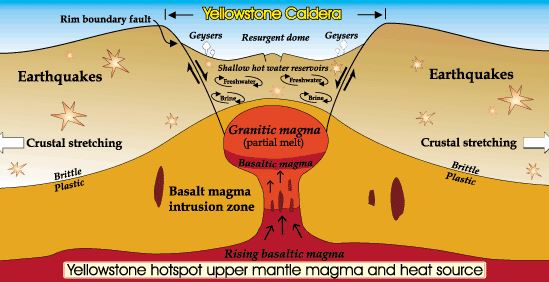
The caldera at Yellowstone was almost entirely formed by the final eruption, the Lava Creek eruption. Unlike most volcanoes, with their recognisable conical shape and caldera sat atop, The Yellowstone Caldera is massive. It’s simply too big to see in a single vista with the naked eye. The volcanic depression was formed during the final eruption not so much by the accumulation of materials around a central caldera as most volcanoes form, but rather by the literal collapse of earth as the staggering amount of materials were blown out into the atmosphere. The caldera, measuring approximately 55 by 72 kilometers (34 by 45 miles) doesn’t really project up into the air like most volcanoes. It could be more accurately described as a void left when the magma chamber beneath the surface emptied during the eruption.
Today, the caldera is a key feature of Yellowstone National Park, encompassing many of the park’s geothermal areas, such as geysers, hot springs, mud pots, and fumaroles. These geothermal features are fueled by the heat from the underlying magma chamber, providing a constant reminder of the volcanic activity beneath the surface.
Magma Chamber
These days, The magma chamber beneath Yellowstone is one of the largest known magma reservoirs in the world. Seismic imaging and other geophysical techniques have revealed its size, depth, and composition. The upper magma chamber is estimated to be about 90 kilometers (56 miles) long, 40 kilometers (25 miles) wide, and 10 to 12 kilometers (6 to 8 miles) deep. The upper chamber lies about 5 to 17 kilometers (3 to 10 miles) beneath the surface. Beneath this, there is a deeper magma reservoir that is approximately 4.5 times larger and extends down to depths of 20 to 50 kilometers (12 to 31 miles). The magma is primarily composed of rhyolite, a high-silica volcanic rock that is very viscous and capable of producing explosive eruptions. The deeper reservoir contains basalt, which can inject heat and material into the upper chamber, potentially triggering an eruption.
There are some in the geological community who say that the sleeping beast of Yellowstone is overdue. Since the Huckleberry Ridge eruption, Yellowstone has erupted roughly every 600,000 years. We’re now at 640,000 years since the final supereruption….and there are signs that the beast may be waking from its long slumber.
Signs of a Pending Eruption
Increased Earthquakes: One of the most significant signs of volcanic activity is an increase in the frequency and magnitude of earthquakes in the region. A notable rise in seismic activity could indicate that magma is moving beneath the surface. Across the park and wider region, hundreds of seismograph stations record thousands of earthquakes, large and small. These seismographs show a substantial increase in the number and size of these quakes which could signal magma movement. Some of these are known as swarm earthquakes, where a number of earthquakes occur over a very short period of time.
Ground Uplift and Subsidence: Changes in the ground level, known as deformation, can indicate magma accumulation. Ground uplift occurs when magma accumulates beneath the surface, causing the ground to rise. Conversely, ground subsidence can occur when magma withdraws or migrates. At Yellowstone, the Yellowstone Volcano Observatory (YVO) uses GPS and InSAR (satellite radar) to measure these deformations. There are examples of both uplift and subsidence throughout the park. The Norris Geyser basin uplifted 12cm between 1996 and 2003, and a further 5cm in 2013 and 2014 The Mallard lake and Sour Creek resurgence domes raised by around 7cm per year between 2004 and 2010. Between 1972 and 1984 the Yellowstone caldera experienced an uplift of a whopping 72cm. Whilst these numbers may not sound significant, the only force capable of moving the sheer amount of earth is the movement of the magma chamber beneath the surface.
Changes in Geyser and Hot Spring Activity: Yellowstone is renowned for its geothermal features, including geysers, hot springs, and fumaroles. The biggest geyser on earth has shown some alarming changes in recent years. The Steamboat geyser, found in the Norris geyser basin, was once an infrequent sight to behold, however, since 2018 it has erupted its 90 meter plume dozens of times per year. Even old faithful, once so regular you could set your watch by it, has become inconsistent in its eruptions. The Ear Spring was formally known for its minor bubbling activities suddenly erupted in September of 2018, interestingly, water was not the only material to be ejected. Also found were numerous coins of different nationalities, various tourist offcasts such as drinks cans and cutlery, a single pair of shoes (size unspecified) and a babies pacifier, but no baby.
Hydrothermal Explosions: Hydrothermal explosions should not be confused with geyser activity. They occur when water trapped in the ground is heated by magma, turning it into steam and causing an explosion. While these explosions are typically small and localized, an increase in their frequency or intensity can be a warning sign.
Increased Gas Emissions:Volcanic gases, particularly sulfur dioxide (SO2), carbon dioxide (CO2), and hydrogen sulphide (H2S), are released from magma as it rises toward the surface. At Yellowstone, gas emissions are monitored by collecting samples from fumaroles and hot springs, as well as by using airborne and ground-based sensors. Increases in all of the above mentioned gasses have been measured throughout the park at Yellowstone.
Impact of a Future Eruption
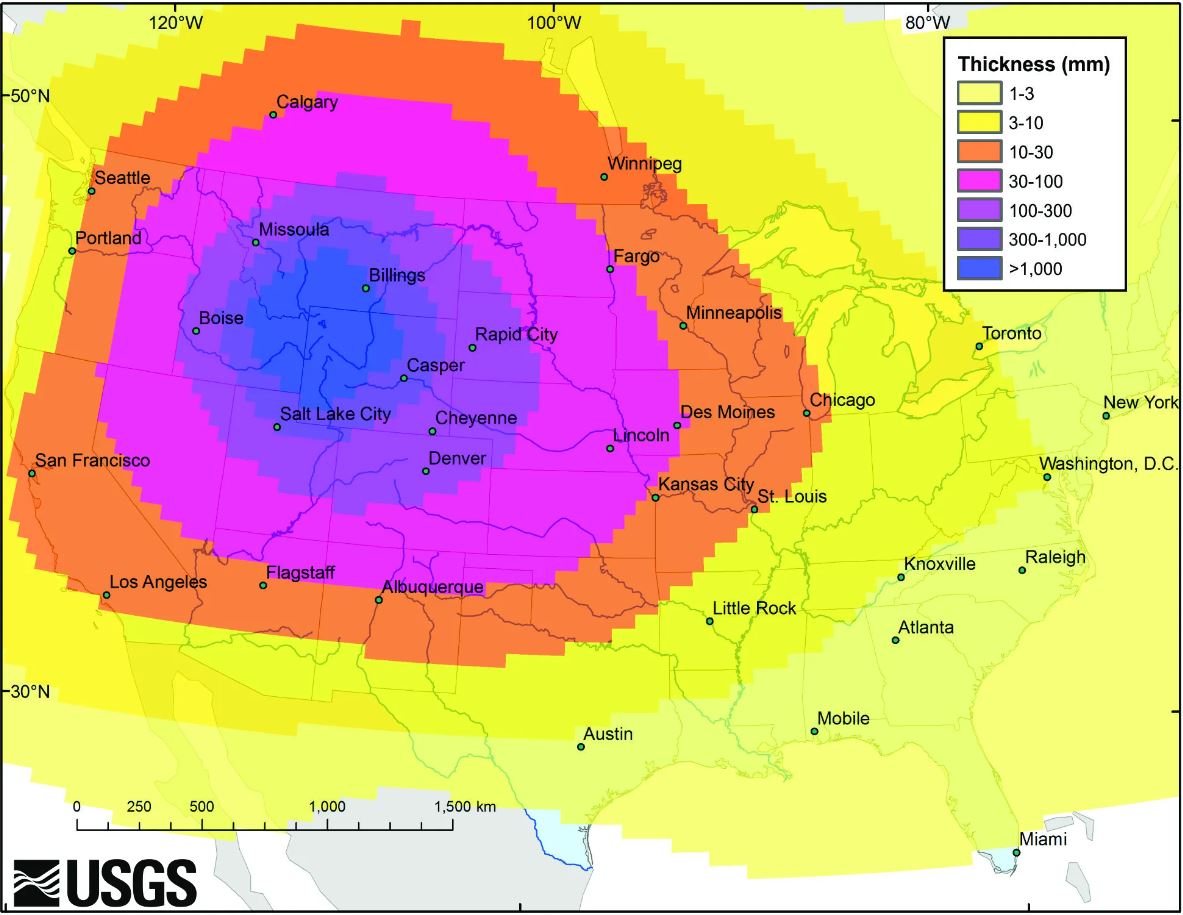
A future eruption of the Yellowstone Supervolcano would have catastrophic consequences on both a regional and global scale. While the likelihood of such an event occurring in the near future is low, understanding the potential impacts is crucial for preparedness and risk mitigation.
Regional Impact
The first impact that we would see were the pyroclastic flows. we simply have no means of assessing how far and fast the pyroclastic flows would emanate from the next supereruption. The best example in recent memory saw pyroclastic flows racing down the slopes of Mt. St helens at a rate of up to 300km per hour and reaching temperatures of up to 700 celsius. Unless you happen to be a pilot able to get off the ground real fast, there is simply no way of a human to outrun this and anything caught in this flow would be instantly burned to a crisp. Some estimates say that this alone would kill everything within 100km of ground zero.
Next would come the ashflows. Thick deposits of volcanic ash would cover large areas, causing roof collapses, contaminating water supplies, and destroying crops. Making much of the continental United States uninhabitable. Finally at a regional level, volcanic ash and debris would mix with river and lake water, causing volcanic Lahars. Mudflows that would inundate river valleys and floodplains, causing tidal waves of mud to wash through water systems throughout the continent.
National Impact
The effects of a Yellowstone eruption would extend far beyond the immediate vicinity, impacting much of the United States. Does everyone remember the Icelandic volcano crisis in europe? Eyjafjallajökul brought European air travel to a standstill for weeks with an eruption of just 0.25km of material. If the eruption is anything close to the Huckleberry Ridge eruption, then 9,800 times more material will be entering the atmosphere. At a time when the US really needs the support of its emergency services, armed forces, and any other able man, woman or child, the entire country will find that roads, bridges, and buildings would be damaged or destroyed, critical infrastructure and communications would be damaged, people would be unable to respond in anything like a coordinated fashion. Chaos would rain down alongside the choking ash. Within a few days, ashfall will destroy crops and livestock, leading to food shortages and the collapse of the ability of the US to sustain a population. The economic loss would be total. Cities such as Denver, Salt Lake City and Billings would be caught in the ashfall. Depending on winds, cities as far apart as Los Angeles and New York could also be impacted.
Global Impact
The climatic effects of a Yellowstone eruption would not stop at the US border. The thousands of tonnes of ash and sulfur dioxide injected into the atmosphere would have no respect for national boundaries. It would drift, expand and spread as the winds circled the planet. Even a relatively small amount of ash dispersed in the upper atmosphere would block sunlight, leading to a significant drop in global temperatures. This volcanic winter would last for many years, disrupting global weather patterns and agriculture.
Health Impacts
It will come as no surprise that the health impacts will be immediate. For those people not incinerated in the initial blast, there is now an array of short and long term health implications. The most immediately noticeable will be general irritation as the sharp dust particles irritate eyes, skin and respiratory tract. Depending on the exact nature of the materials being elected and breathed in, this could range from mild eye irritation and coughing through to actual abrasion of the cornea, conjunctivitis and damage to the respiratory tract. Whilst many people will be able to survive, those with pre-existing health problems such as asthma or COPD, the old, and the young would be at high risk of death from this phase.
Longer term impacts will generally be a compounding of the short term issues. Silicosis and chronic bronchitis will be widespread due to long term exposure to breathing fine dust particles. Cancer rates would spike through a combination of exposure and lack of access to medical treatment. The lack of access to medical treatment would lead to an increase in the instances and severity of all health issues whether related to the eruption or not.
One of the more grizzly impacts on health will come from your fellow humans. As people become more and more desperate to compete for fewer and fewer resources, the population will collapse. Emergency services and the military will be unable to render assistance to most of the population. Things will likely quickly descend as people resort to ever more extreme measures to ensure their own safety and survival. Beware of your fellow man!
Cities in the Blast Radius
The extent of the blast radius would depend on the scale of the eruption. In a worst-case scenario, major cities within several hundred miles, including Denver, Salt Lake City, and Billings, could experience severe ashfall and infrastructure damage. The effects could extend even further, impacting cities like Chicago and New York with lighter ashfall and associated disruptions.
Yellowstone as a National Park
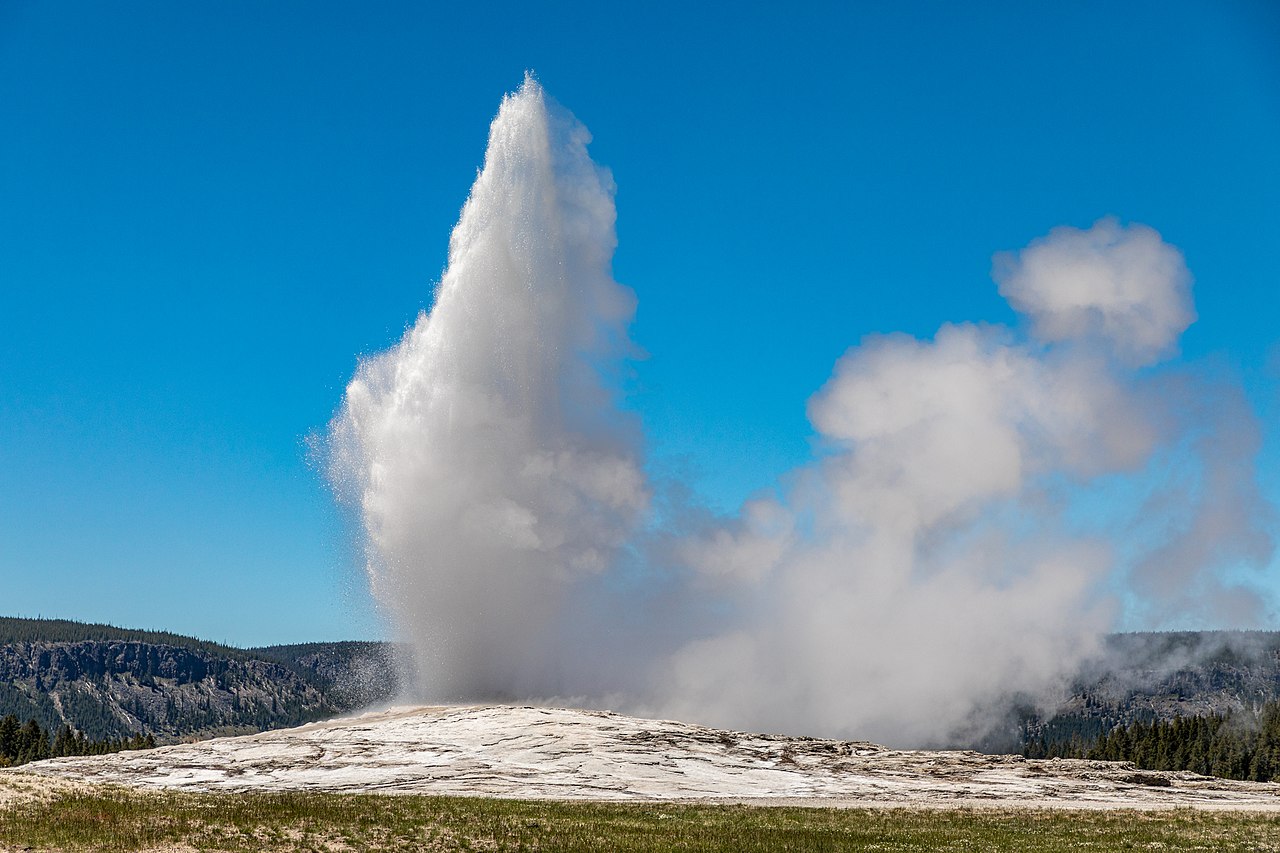
Whilst the existence of the supervolcano may be alarming, life in the park today is nothing short of idyllic. Yellowstone attracts millions of visitors each year. Those very same geological features that indicate the existence of the supervolcano beneath, including Old Faithful, the Grand Prismatic Spring, and numerous geysers and hot springs are the very reason that over 4 million people visit each year.
Yellowstone also boasts diverse ecosystems, including forests, grasslands, and alpine environments, which support a wide range of wildlife. Species such as the Gray Wolf, Bald Eagle and the iconic Grizzly bear all call Yellowstone home. Over the past few decades, steps have been taken to further enhance the natural biodiversity with several very successful schemes to reintroduce species once eradicated from the park. Species such as the Gray Wolf, American Bison, Beaver and Peregrine Falcon have all been reintroduced to the park.
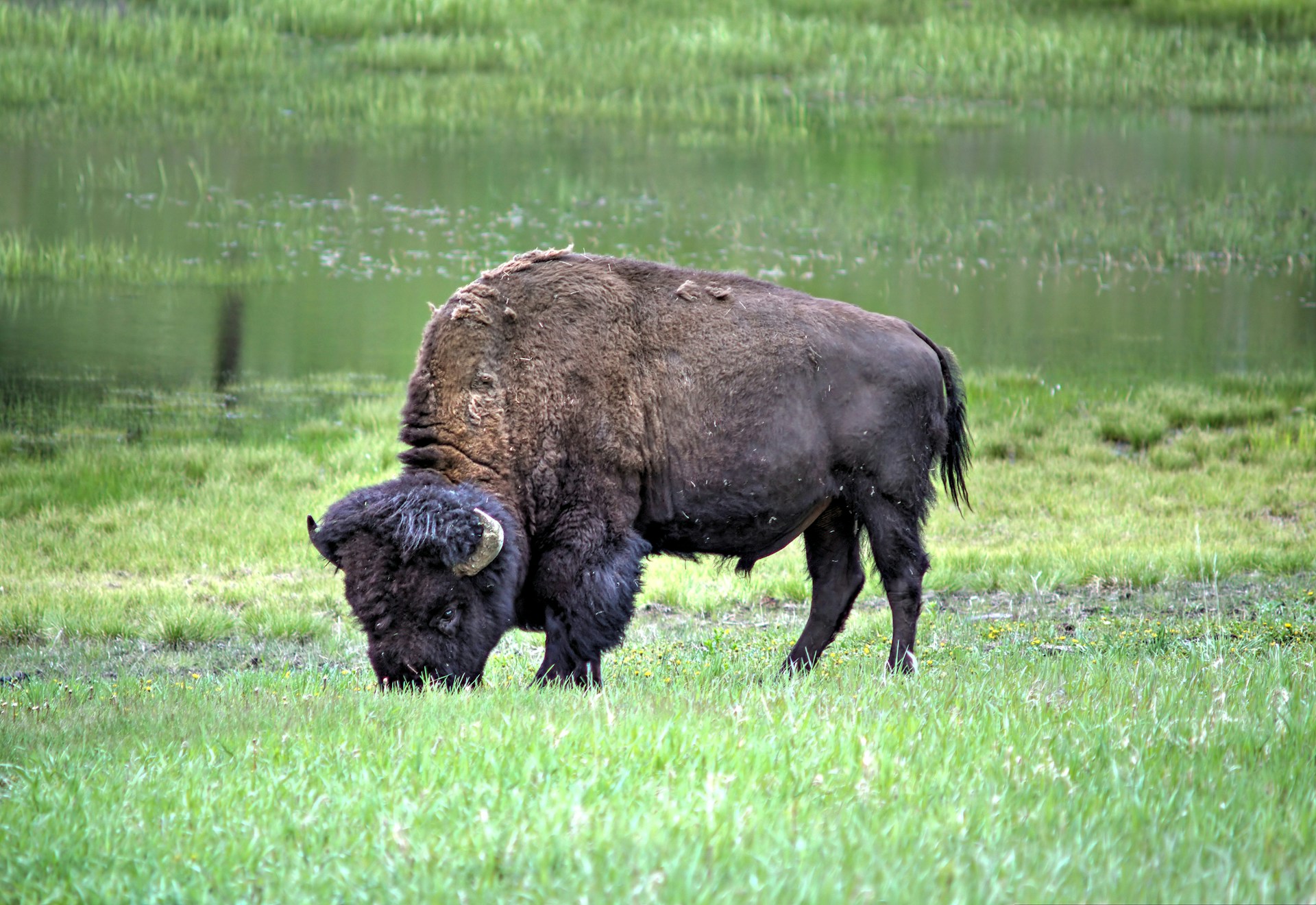
The Yellowstone Supervolcano is a geological marvel with the potential for devastating eruptions. It is impossible to tell the likelihood of how and when the next major eruption will take place, if at all. Ongoing monitoring and research are essential for understanding and mitigating the risks. Yellowstone National Park remains a vital natural and scientific resource, attracting millions of visitors each year and providing valuable insights into the Earth’s volcanic processes. By studying the past and preparing for the future, we can better appreciate and protect this unique and powerful feature of our planet.

